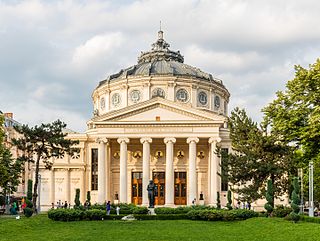
Bucharest is the capital and largest city of Romania. It is described as the cultural, financial, entertainment, and media center in the country with a significant influence in Eastern and Southeastern Europe as well. It is also a city with a significant influence in terms of education, tourism, research, technology, health care, art, fashion, sports, and politics. It is located in the south-east of Romania, on the banks of the Dâmbovița river, less than 60 km (37.3 mi) north of the Danube River and the border with Bulgaria. It is also one of the most populated cities of the European Union (EU) within city limits and the most populated capital in Southeastern Europe. It was the capital of Wallachia from 1659 to 1859 and the capital of the United Principalities of Moldavia and Wallachia from 1859 to 1881.

The Palace of the Parliament, also known as the Republic's House or People's House/People's Palace, is the seat of the Parliament of Romania, located atop Dealul Spirii in Bucharest, the national capital. The Palace reaches a height of 84 m (276 ft), has a floor area of 365,000 m2 (3,930,000 sq ft) and a volume of 2,550,000 m3 (90,000,000 cu ft). The Palace of the Parliament is the heaviest building in the world, weighing about 4,098,500,000 kilograms, also being the second largest administrative building in the world.
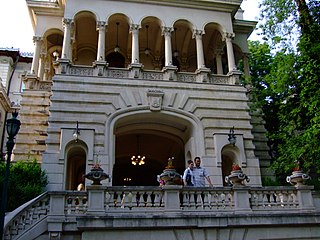
Cotroceni Palace is the official residence of the President of Romania. It is located at Bulevardul Geniului, nr. 1, in Bucharest, Romania. The palace also houses the National Cotroceni Museum.

Margareta, Custodian of the Crown of Romania is the eldest daughter of King Michael I and Queen Anne of Romania. She assumed her father's duties in March 2016, upon his retirement, and has claimed the headship of the House of Romania since his death on 5 December 2017. She also heads the Margareta of Romania Royal Foundation.
Crețulescu Palace is a historic building near the Cișmigiu Gardens on Știrbei Vodă Street nr. 39, in Bucharest, Romania. It was built for the Crețulescu family in 1902–1904 by Romanian architect Petre Antonescu (1873–1965).

The National History Museum of Romania is a museum located on the Calea Victoriei in Bucharest, Romania, which contains Romanian historical artifacts from prehistoric times up to modern times.

Telephones Company Building is an Art Deco office building located on Calea Victoriei in Bucharest, Romania. It is now owned by Telekom România.
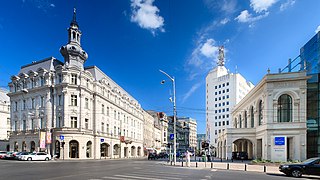
Calea Victoriei is a major avenue in central Bucharest. Situated in Sector 1, and having a length of 2.7 kilometres (1.7 mi), it leads from Splaiul Independenței to the north and then northwest up to Piața Victoriei, where Șoseaua Kiseleff continues north.

Șoseaua Kiseleff is a major road in Bucharest, Romania. Situated in Sector 1, the boulevard runs as a northward continuation of Calea Victoriei.

Carol I Park is a public park in Bucharest, Romania, named after King Carol I of Romania. A French garden located in the southern-central area of Bucharest, partly on Filaret hill, originally capable of hosting various exhibitions, it suffered considerable modifications during the communist regime, including a name change to Parcul Libertății.

The Palace of the Chamber of Deputies is a building in Bucharest, Romania located on the plateau of Dealul Mitropoliei. The building served as the seat of successive Romanian legislatures: of the Assembly of Deputies during the Kingdom of Romania, then of the Communist-era Great National Assembly, and after the Romanian Revolution of 1989, of the Chamber of Deputies. Parliamentarians vacated the building in 1997, when it passed to the Patriarchate of the Romanian Orthodox Church.
Romanian architecture is very diverse, including medieval, pre-World War I, interwar, postwar, and contemporary 21st century architecture. In Romania, there are also regional differences with regard to architectural styles. Architecture, as the rest of the arts, was highly influenced by the socio-economic context and by the historical situation. For example, during the reign of King Carol I (1866–1914), Romania was in a continuous state of reorganization and modernization. In consequence, most of the architecture was designed by architects trained in Western European academies, particularly the École des Beaux-Arts, and a big part of the downtowns of the Romanian Old Kingdom were built during this period.

Elisabeta Palace is a palace on Kiseleff Road in Bucharest, Romania. Built in 1936, it is the official residence in Romania of Margareta of Romania, her husband Prince Radu, and her sister Princess Maria.
CEC Bank, is a state-owned Romanian banking institution.
The Decorations of the Romanian Royal House are a reward for conspicuous and special merits of the recipients for the Romanian state and the Romanian Royal House.
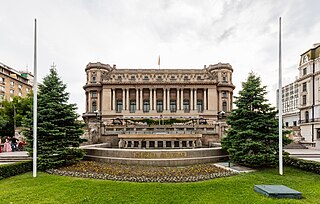
The Palace of the National Military Circle, also known as the Officers' Circle Palace is located on Constantin Mile street in Bucharest, Romania. It was built in 1911, based on plans drawn by chief architect Dimitrie Maimarolu, using French neoclassical style. The beneficiary was the Officers' Circle of the Bucharest military garrison, which was founded in 1876.

Alexandru Săvulescu (1847–1902) was a Romanian architect, one of his country's first prominent practitioners of modern architecture. He combined elements of traditional Byzantine architecture and Romanian architecture with French Art Nouveau in an eclectic style. He served as the chief architect for the Ministry of Public Education and Religious Affairs and the president of the Romanian Society of Architects. He helped found both the latter organization and the Romanian National School of Architecture. Some of his most renowned buildings are the Communal Palace of Buzău, the Noblesse Palace and the Post and Telegraph Palace, which now houses the National Museum of Romanian History.

Noblesse Palace is a historical monument in Bucharest, Romania. The architecture of the building is in eclectic style built by architect Alexandru Săvulescu. It has 30 rooms on an area of 1100 square meters. In the first phase, it was used as a bank and home by the Berkowits. It became an important cultural centre, including the Noblesse Interiors showroom and the Noblesse Art Gallery.
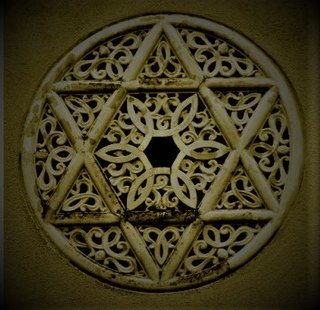
The 'Faith Temple' also Templul Credința, Sinagoga Credinta, Templul Hevrah Amuna is a Jewish synagogue, built in 1926, that is located on 48 Toneanu Vasile Street in Bucharest, Romania.

Romanian Revival architecture is an architectural style that has appeared in late 19th century in Romanian Art Nouveau, initially being the result of the attempts of finding a specific Romanian architectural style. The attempts are mainly due to the architects Ion Mincu (1852–1912), and Ion N. Socolescu (1856–1924). The peak of the style was the interwar period. The style was a national reaction after the domination of French-inspired Classicist Eclecticism. Apart from foreign influences, the contribution of Romanian architects, who reinvented the tradition, creating, at the same time, an original style, is manifesting more and more strongly. Ion Mincu and his successors, Grigore Cerchez, Cristofi Cerchez, Petre Antonescu, or Nicolae Ghica-Budești declared themselves for a modern architecture, with Romanian specific, based on theses such as those formulated by Alexandru Odobescu around 1870:
"Study the remains – no matter how small – of the artistic production of the past and make them the source of a great art (...) do not miss any opportunity to use the artistic elements presented by the Romanian monuments left over from old times; but transform them, change them, develop them ..."





















